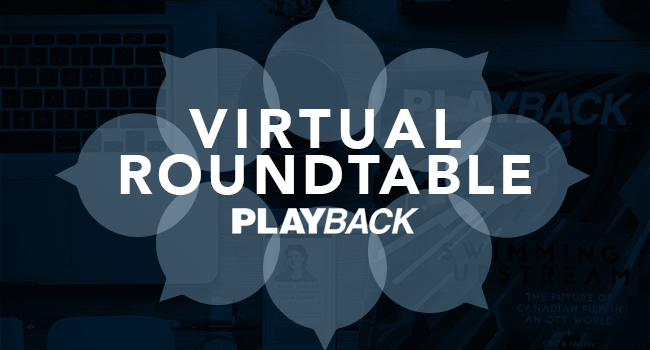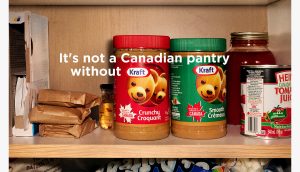This virtual roundtable originally appears in MiC sister publication Playback.
The COVID-19 pandemic has upended every aspect of the Canadian production industry over the past six weeks, and looks set to do so for months and potentially years to come. And while the economic impact on the Canadian screen industry is moving more clearly into focus – CMPA projections estimate that the shutdown will put $2.5-billion of production spending at risk by the end of June – the fast-changing nature of the situation means companies across the sector are being forced to pivot on a daily basis and adapt their operations to ever-changing business realities.
Here, in part two of Playback‘s second virtual roundtable, Canadian broadcast heads discuss regulatory obligations, supporting the production community, leading during a time of crisis and opportunities to sell Canadian fare internationally. See part one of the discussion here.
Participants in the discussion are: Monika Ille, CEO of APTN; Barb Williams, EVP at CBC; Troy Reeb, EVP of broadcast networks at Corus Entertainment; Jamie Schouela, president of Canadian media at Blue Ant Media; and Brad Danks, CEO of OUTtv.
Diving a bit further into the production shutdown, what does it mean for your organization?
 Monica Ille: One of our big concerns is that we work with smaller independent production companies and sometimes they live from project to project. They can’t shoot now and I know some are concerned they might not even make the year. We’re in constant communication with them, trying to find ways to support them. We’re privileged in the sense that we’ve got stable funding for the moment and we’re thinking about how producers benefit from that.
Monica Ille: One of our big concerns is that we work with smaller independent production companies and sometimes they live from project to project. They can’t shoot now and I know some are concerned they might not even make the year. We’re in constant communication with them, trying to find ways to support them. We’re privileged in the sense that we’ve got stable funding for the moment and we’re thinking about how producers benefit from that.
Right now we’re brainstorming different types of programming that can be done within confinement, because we don’t know how long this will last and we’ll get to a point where we need to refresh our programming. It’s not the [highest-quality] content, but at this point I think people are forgiving of the production quality – it’s what is said that’s important.
We’re OK for spring and summer, but for fall we have those holes to fill, so we’re starting to think of what we can do right now, taking into account the resources and equipment that producers have at home.
 Barb Williams: Obviously the CBC’s primetime schedule is driven by Canadian originals, so the gap is huge. We have so much that typically would be in production now, so we’re in an interesting place to think about how we’re going to manage a fall schedule. That leads to the conversation that Troy [Reeb] touched on of constant communication with the CRTC, and being really clear about what the challenges are and seeing what support we can get.
Barb Williams: Obviously the CBC’s primetime schedule is driven by Canadian originals, so the gap is huge. We have so much that typically would be in production now, so we’re in an interesting place to think about how we’re going to manage a fall schedule. That leads to the conversation that Troy [Reeb] touched on of constant communication with the CRTC, and being really clear about what the challenges are and seeing what support we can get.
We are also in regular conversation with the Canada Media Fund (CMF), trying to understand what it means for the projects they’re supporting this year, and how those dollars will travel with shows. [For example], will we be able to move dollars over a two-year period [with the CMF] if we can’t get everything happening this year? The CMF is being very thoughtful with all of us and is continuing to be supportive and helpful over the longer term as we figure that out.
We also feel a real responsibility to support the production community. We launched the Creative Relief Fund in order to get some money in the hands of producers and get some development happening, even if it can’t turn into production right away. We have a creative community out there whose brains are still buzzing with ideas and they don’t have a place to put that creative energy, so we’re hoping we’ll hit a very innovative time with our producers and support them financially with this fund. A piece of it is going to short-term docs, where we’re asking producers and filmmakers to do short pieces about their isolation experience. We think we can turn some of that around very quickly and get the content up on Gem or our other feeds right away, and maybe some of it even on linear.
Jamie Schouela: The truth is, I don’t know what we need quite yet in terms of regulatory relief. We’re in the middle of this and trying to figure out what the short- and long-term impact is and so what we’ve done is simply reached out to engage [the CRTC] in a dialogue and tell them where we’re at and try to share our business experience on the ground. Of course, it will be different for everyone but we’re trying to share what we see and what we’re hearing from advertisers, producers and others. The fact is, we just can’t commission – we can’t create right now. So that’s not going to allow us to hit some basic [regulatory] obligations on the creation side. We’re just going to have to work together to figure this out. I don’t think we sit here knowing exactly what we need or what we can ask [the Commission] right now – we have to understand how this plays out a bit more, truthfully.
 Brad Danks: To their credit, the CRTC has been really good at reaching out and asking us to put together a list of things that we need. CPE is the most obvious one, with most of us having our broadcast year end in August. This is typically a time of year when we’re producing and doing a lot of things in order to meet those obligations, and [CPE] is a real problem for us right now. No one is going to be able to meet that and I’m quite sure the CRTC is going to do something about that for all of us. But that’s what everyone wants to know, because otherwise we’re going to have to change from original shows, or whatever it is we’re doing, and begin acquiring Canadian content or something like that, and that wouldn’t make any sense business-wise.
Brad Danks: To their credit, the CRTC has been really good at reaching out and asking us to put together a list of things that we need. CPE is the most obvious one, with most of us having our broadcast year end in August. This is typically a time of year when we’re producing and doing a lot of things in order to meet those obligations, and [CPE] is a real problem for us right now. No one is going to be able to meet that and I’m quite sure the CRTC is going to do something about that for all of us. But that’s what everyone wants to know, because otherwise we’re going to have to change from original shows, or whatever it is we’re doing, and begin acquiring Canadian content or something like that, and that wouldn’t make any sense business-wise.
Troy Reeb: There are two streams to this challenge with the sharp decline in ad revenue. For entertainment-focused specialty channels, there continues to be subscription revenue that is brought in, which is helping to hold up revenues overall. And some of that cost challenge will simply be met by an understanding from the CRTC that CPE simply can’t be met in the current environment.
On the other side is the conventional TV business, which is entirely ad-supported and carries a tremendous regulatory burden in terms of the levels of local programming that are required. That’s a whole different challenge. There’s the CPE side of the equation, and then there are the regulatory burdens that are placed on the conventional broadcast sector, which as you know from CRTC returns is not a profitable sector. You can parse out each individual broadcaster as to how they do, but according to the commission the conventional over-the-air broadcasting system is not a money maker in this country. And, with a giant collapse in ad revenue, there needs to be something else done to support that, because right now it is providing the majority of the news content that, I think the government would agree, is most in demand and in need by Canadians.
Are there any innovations that are being implemented now that will influence your operations beyond the pandemic?
 Schouela: We’ve been thrilled, impressed and a little surprised with how smoothly things have run remotely. This is perhaps not only true for our sector, but, in terms of work life and office life in general, there will be a lot of thinking about people being physically in an office five days a week. We’re trying to think about being a little more open to having people working remotely at times, or a couple days a week.
Schouela: We’ve been thrilled, impressed and a little surprised with how smoothly things have run remotely. This is perhaps not only true for our sector, but, in terms of work life and office life in general, there will be a lot of thinking about people being physically in an office five days a week. We’re trying to think about being a little more open to having people working remotely at times, or a couple days a week.
There’s no substitute for face-to-face time in the office for sure, but I think there’s a bigger learning out of this. It’s not just people with laptops and other stuff working remotely – we also have technical roles working remotely. We have editing being done remotely, we’ve run our master control room remotely as part of this process. We’ve learned a lot technologically. We’re going to take some of that and build and learn from it.
Williams: You’ve raised something that has been a very interesting piece of the experience for us. As leaders of large organizations, we’re thinking about what the right way is to continue to lead a motivated, engaged and proactive team remotely, and rethinking our communication platforms, standards and practices, because people will need different things now we’re doing everything from home.
As a leader, I’m feeling the responsibility to continue to talk a lot with our employees about the stress and strain of working from home. We have a lot of people with young families at home who are trying to juggle career and kids, [without knowing] when schools or day-cares will reopen. There’s a wear and tear on people, with this 24/7 lifestyle that they’re now being asked to merge in their home. It’s very challenging for a lot of people on their mental health, on their family life, so we will gain some best practices about flexibility.
Ille: Like Barb said – flexibility. We’re using lots of flexibility and accommodating people as much as we can, because this crisis is not just a health crisis. It’s an economical crisis. It’s a spiritual crisis when you think about it. It’s emotional, it’s everything.
What are some of your longer-term concerns for Canadian broadcast networks? And, on a brighter note, could we see more Canadian product sold internationally as a result of the production shutdown?
 Reeb: First off, I think longer term we’re all concerned about when production will come back. How do we maintain a supply of fresh content onto our networks and platforms? What’s the audience’s capacity for re-runs and are there other sources of content that we can turn to for fresh content? That means looking beyond the traditional suppliers.
Reeb: First off, I think longer term we’re all concerned about when production will come back. How do we maintain a supply of fresh content onto our networks and platforms? What’s the audience’s capacity for re-runs and are there other sources of content that we can turn to for fresh content? That means looking beyond the traditional suppliers.
And to the second question, the answer is yes. We’re also a producer of content and we’ve already been fielding more inbound calls from networks worldwide, looking to ensure they have a supply of content that is interesting and fresh, and there probably is potential here for more Canadian shows, not only in the U.S but overseas.
Schouela: We’re also seeing an influx of demand from a distribution perspective. Global broadcasters and streamers are going to look for finished content wherever they can find it now, and so anyone who has interesting archives of finished, ready-to-go content is going to be a solution for lots of markets.
And to the point of when production is going to fire up again: one of the things we’re starting to think about is sources of content. There are territories and areas around the globe that have been less affected than North America from a COVID perspective. So as markets open up in different parts of the world, where might production start up first or where is production most likely to happen? For example, we own production businesses in Australia and New Zealand, which have been less affected by COVID than other markets around the world and are hopefully quicker to reduce their government guidelines to start doing production again. We’re starting to think about whether those sources of future content. So, if we can’t get it from the North American pipelines, could we get it from other parts of the world that might be quicker to resume production, and lean on them for some output or some acquisitions.
Danks: On the programming side, one of the things that’s happened is that it has accelerated a lot of our platform deals. Right now, we’re pushing hard to get into the AVOD platforms in the U.S and we’ve been able to get four of those deals done in the last month, as well as three international deals. So they were moving, but they’ve all accelerated now and there’s more coming up because everyone is in a hurry to move forward. The general trend is that all of the things that were happening in the industry are picking up pace right now.
Keep up with Playback‘s ongoing coverage of COVID-19 here.
























